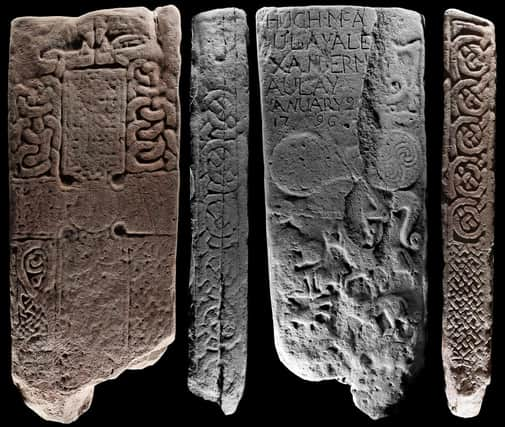Lost Pictish stone decorated with massive mythical beasts goes on show for first time


The 1,200 -year-old stone was found in a church graveyard in the Conon Bridge area by an amateur archaeologist when she brushed away some leaves from a grave.
The rare find has been described as “uniquely significant” by Dr Isabel Henderson, who is widely acknowledged as one of the world's leading authorities on the Picts and their culture.
Advertisement
Hide AdAdvertisement
Hide AdNow known as the Conan Stone, it is now on show in the window at Dingwall Museum after £20,000 was raised by the North of Scotland Archaeological Society and the Pictish Arts Society to remove and restore the cross-slab.
Anne MacInnes, who discovered the stone, said: “When the Conan Stone is unveiled in the window of Dingwall Museum it will be the culmination of a journey that started when I brushed back some leaves from a graveslab.
"From the moment of realisation that it was a Pictish stone to its installation in the Museum has proved to be quite a journey involving huge commitment and cooperation from many people in different capacities. “
The stone, which had lain on the ground as a grave marker since at least the 1700s, currently measures 1.5 metres tall but it is thought it may have originally stood almost a metre taller.
The stone is decorated with a number of Pictish designs, including several mythical beasts, an oxen, an animal-headed warrior with a sword and shield and a Christian cross.
It is one of around 50 complete or near complete Pictish cross-slabs known in the world, and the first to be discovered on the Scottish mainland for many years
John Borland, President of the Pictish Arts Society, said Easter Ross had particular importance in Pictish times with the Conon Stone adding more ‘exciting’ information to the story given the two massive beasts that decorate it.
Mr Borland said: “Easter Ross is home to many fine Pictish sculptured stones and yet this latest discovery still manages to add something new and exciting to that collection. The two massive beasts that flank and surmount the cross are quite unlike anything found on any other Pictish stone."
Advertisement
Hide AdAdvertisement
Hide AdDr Isabel Henderson, co-author of 'The Art of the Picts' added: "The new Dingwall cross-slab is a uniquely significant western extension of the prestigious Pictish symbol-bearing relief sculpture of Easter Ross, notably connected with the tall slabs of Shandwick and Rosemarkie."
At Dingwall, the stone can now be seen in the window of the museum, which remains closed due to pandemic restrictions.
Ian MacLeod, museum chairman, said “This special stone will enhance our collection and it will be safeguarded for future generations to see.
"It should also increase visitor numbers to the Museum. I have been very impressed with everyone who has worked along with the Museum team, and special mention must go to the local specialists and tradesmen who gave their time and expertise to complete the installation. We look forward to opening the Museum next year.”
A conference, at which a number of experts will speak about the importance of the find, is due to take place online in March 2021.
